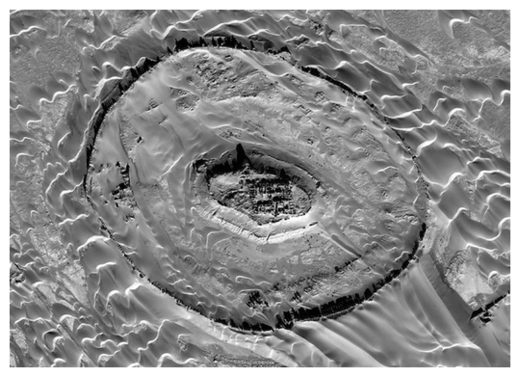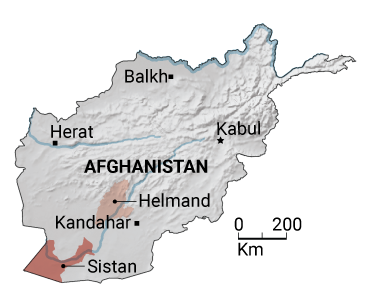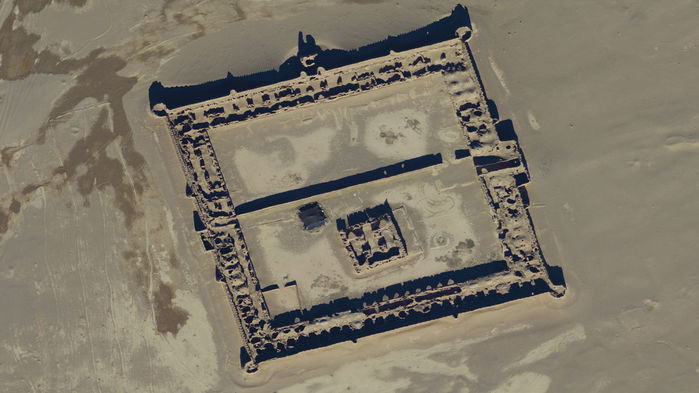In a collaboration funded by the U.S. Department of State, archaeologists are analyzing commercial satellite data, along with U.S. spy satellite and military drone images, which offer a fine-grained view of remote sites that are too dangerous for researchers to visit. At a meeting here last month of the American Schools of Oriental Research, team members said they have more than tripled the number of published archaeological features in Afghanistan, to more than 4500. The discoveries range from caravanserais, huge complexes designed to house travelers and built from the early centuries B.C.E. until the 19th century, to networks of ancient canals invisible from the ground. Meanwhile, octogenarian archaeologists are emerging from retirement to add information from decades-old fieldwork to the site inventory.
"The capability to explore a relatively little known region efficiently and safely is really exciting," said David Thomas, an archaeologist at La Trobe University in Melbourne, Australia, who has done remote sensing work in Afghanistan but is not a member of the mapping team. "I'd expect tens of thousands of archaeological sites to be discovered. Only when these sites are recorded can they be studied and protected."
The Afghan Heritage Mapping Partnership is the brainchild of archaeologist Gil Stein of the University of Chicago (UChicago) in Illinois. In 2014, he and other cultural heritage experts met with Afghan President Mohammad Ashraf Ghani, who earned a Ph.D. in anthropology from Columbia University and served as the World Bank's top anthropologist. Ghani called for a detailed effort to map relics of the country's past. "He said cultural heritage is a key to economic development and, in a country so divided, critical for a strong national identity," Stein recalls.
The following year, the State Department awarded a $2 million grant to Stein's team, and gave it access to U.S. government imagery that is often an order of magnitude more precise than publicly available images.

The caravans carried enormous amounts of silks, gems, spices, and woods from India, plus porcelain from China and less exotic cargo such as dried fish, says Emily Boak, a UChicago heritage analyst. The regularity of caravanserai construction suggests an ambitious and centrally sponsored effort to ensure a safe and steady flow of goods, she noted. That contradicts previous ideas that the Safavid Empire - which stretched from Turkey to Pakistan and made Shia Islam its official religion by the 17th century - was in decline in this period.
"There is a long-standing view that once the Portuguese entered the Indian Ocean" - opening sea lanes to Europe in the 16th century - "no one bothered to cross Central Asia," said project manager Kathryn Franklin, also of UChicago. "But this shows a huge infrastructure investment of the Safavids a century later."
Comment: Hardly. Africans, Arabs, Persians, Indians, Malay/Indonesians, and Chinese were all using Indian Ocean shipping lanes long before the Portuguese arrived.
To the north, around the Balkh Oasis bordering Uzbekistan, UChicago's Anthony Lauricella and Emily Hammer, now at the University of Pennsylvania, examined extremely high resolution satellite and aerial images that can spot subtle changes in topography as small as 10 centimeters across and 50 centimeters high. The images, obtained from the U.S. Army Corps of Engineers, revealed hundreds of settlements built over more than a millennium as the Balkhab River shifted course from the early centuries B.C.E. to medieval times and people followed the water in this otherwise arid landscape. Decades ago, Soviet archaeologists noted 77 large settlements there, but the UChicago group counted more than 1,000 ancient villages, towns, or cities, suggesting that the area was far more densely populated over an extended period than once thought. The data will help archaeologists trace a central locus of the Silk Road linking Europe and China. By matching a handful of dated sites with the movement of the river in time, they can even begin to date the settlements.

Most of the 200 sites they pinpointed were built during the Parthian Empire, which flourished at the same time as Rome, in the early centuries B.C.E. and C.E. Features include an extensive canal system that likely boosted crop yields for nearly a millennium. And within just one valley, the team found a variety of religious buildings, including Buddhist stupas, Zoroastrian fire temples, and Hellenistic sanctuaries with both Greek and Aramaic characters written on stone slabs. The finds suggest that the mostly Zoroastrian Parthians tolerated a host of traditions.
To prevent or at least limit destruction of sites like these, Stein is overseeing construction of a geographical information system for the Afghan Institute of Archaeology in Kabul and Kabul Polytechnic University, which could guide future development and serve as a model for other central Asian nations. "This technology for cultural heritage management is very crucial," said Noor Agha Noori, director of the institute.
The Taliban hurt Afghanistan's cultural heritage in the past, for example by smashing the great Bamiyan Buddhas in 2001 and destroying artifacts in the National Museum in Kabul. One of the surprises of the UChicago effort is that destruction of ancient sites today is actually worse outside of Taliban-controlled territory. The new threat is development, from mines to roads, plus old-fashioned looting. Noori hopes the mapping project will give archaeologists a role in protecting Afghanistan's past as it struggles to create a more peaceful and prosperous future.




Comment: What a rich article!
So we've learned that Afghanistan likely had a radically different climate and was part of a highly developed civilization until relatively recently.
Just as soon as it can shake off the virus it is currently fighting, Afghanistan will be restored to its former glory.